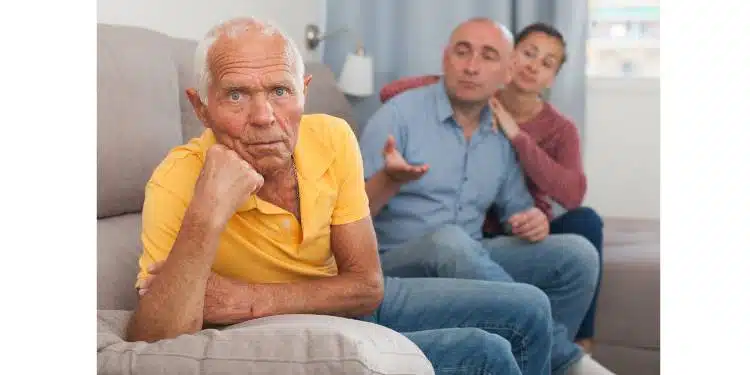by Ellen Blake
Picture this: you’re at a family gathering, laughter echoing around the table with plates piled high with food. You manage a weak smile, pushing aside the nausea churning in your stomach. Every step feels heavy, a dull ache throbbing in your joints. You excuse yourself early, collapsing onto the couch, invisible waves of fatigue washing over you. This, my friends, is the reality of living with an invisible illness, compounded by the silent sting of ageism.
Everyone experiences fatigue or has aches and pains sometimes. But for those of us battling chronic conditions like fibromyalgia, chronic fatigue syndrome, or autoimmune diseases, it’s not just occasional tiredness or ache. It’s a constant companion, one that steals energy and joy. We try to mask it with a smile and a “Fine, thanks.”

Ageism and Invisible Illness
When you add a healthy dose of ageism to the mix, suddenly, our struggles become even more invisible. “You’re just getting old,” they say. Or maybe they don’t say it, but you feel like that’s what they are thinking based on their reactions. I don’t know about you, but these dismissals cut deep, leaving me feeling isolated, unheard, and misunderstood.
I understand younger family members looking at my wrinkles and gray hair thinking I’m just old. I’ve even experienced this attitude with some doctors. But assuming all aches and pains are solely due to age is not only insensitive, it’s inaccurate. Just because I look OK, and it seems my body aged gracefully, doesn’t mean it’s immune to illness. The chances of developing chronic conditions actually increase with age. There is a strong relationship between ageism and invisible illness.
Common Invisible Illnesses
Unfortunately, it’s all too common for people to disregard symptoms of invisible illnesses in older adults or attribute them solely to the aging process. Here are some of the most common invisible illnesses affecting this population and why they might be overlooked:
- Chronic Pain: Conditions like fibromyalgia, osteoarthritis, and rheumatoid arthritis can cause widespread pain and fatigue, and are often dismissed as “just aches and pains” of aging.
- Autoimmune Diseases: Lupus, Sjogren’s syndrome, and celiac disease can have diverse symptoms impacting energy, joints, and digestion, often misconstrued as age-related issues.
- Neurological Conditions: Multiple sclerosis, Parkinson’s disease, and Alzheimer’s disease can have subtle symptoms like tremors, memory lapses, and fatigue, initially attributed to normal decline.
- Mental Health Conditions: Depression, anxiety, and PTSD can impact mood, sleep, and energy levels, sometimes misinterpreted as personality quirks or age-related sadness.
- Chronic Fatigue Syndrome (CFS): This complex condition involves debilitating fatigue and cognitive difficulties, often met with skepticism due to its lack of easily identifiable causes.
“But You Don’t Look Sick”
People disregard the symptoms of chronic disease in elderly adults for a variety of reasons, with ageism being the most common. Societal stereotypes view aging as synonymous with physical and mental decline, leading to the dismissal of these symptoms as “normal” for older adults.
Another common reason is simply a lack of awareness. People may not realize you have aches and pains that people can’t see. Additionally, the nature of invisible illness can make it difficult for individuals to describe their symptoms accurately. Those with mental health conditions may believe there is a stigma attached to their condition and fear judgment, so they may not want to discuss their struggles at all.
Many invisible illnesses are complex and have diverse symptoms. Diagnosis and understanding are therefore often challenging for both individuals and healthcare professionals.

How to Explain an Invisible Illness to Family
Dealing with the physical and emotional toll of an invisible illness, only to have our experiences dismissed as “senior moments” or “part of getting older.” is incredibly frustrating. I feel like I am fighting a battle on two fronts, constantly having to justify and advocate for myself in a world that seems determined to ignore my invisible struggles.
Tips to Explain the Challenges of Invisible Illness
Explaining an invisible illness to the family as an older person is challenging due to ageism and the nature of invisible illnesses themselves. It’s a good idea to prepare yourself before the conversation. Gather your thoughts to determine the best way to help them understand your symptoms and what type of support you need or want.
Here are some tips that might be helpful:
- Start with a clear statement: Briefly explain your diagnosis and the main challenges you face. Use concise terms and avoid medical jargon as much as possible.
- Share your experiences: Describe your symptoms and how they impact your daily life. Be honest about the emotional toll it takes on you.
- Use analogies and comparisons: Relate your experience to something they understand, like fatigue after a long flight or pain from an old injury. This can help them empathize with your invisible struggles.
- Validate their concerns: Acknowledge their confusion or doubts and address them patiently. Offer to answer any questions they might have.
- Focus on specific requests: Instead of vague needs, ask for specific types of support that would be helpful, like accompanying you to doctor appointments, helping with chores, or simply listening without judgment.
- Emphasize the benefits of understanding: Explain how their support can improve your quality of life and strengthen your relationship.
How Can Family Members Help
If you are someone with a loved one who seems to have a chronic illness nobody sees, the best thing you can do is listen, truly listen, when they share their stories. Believe that the pain they describe is real, even if they can’t see it. Educate yourself about the spectrum of chronic conditions and the way they can affect everyday life. Offering support is a small but mighty gesture that can provide a lifeline to your loved one. A little compassion goes a long way toward creating a world where everyone, regardless of age or condition feels truly seen and heard.
Conclusion
It’s up to us to educate people about our invisible health issues and help them understand that age is just one factor in health. Invisible illness is a battle often fought in silence, which is part of why their effects are misinterpreted as inevitable signs of aging. Only through open communication with trusted loved ones or healthcare professionals can we begin to get the help we need and want.
Resources
Here are some resources that we hope will be helpful.
FAQs
Here are some commonly asked questions about the relationship between ageism and invisible illness.











